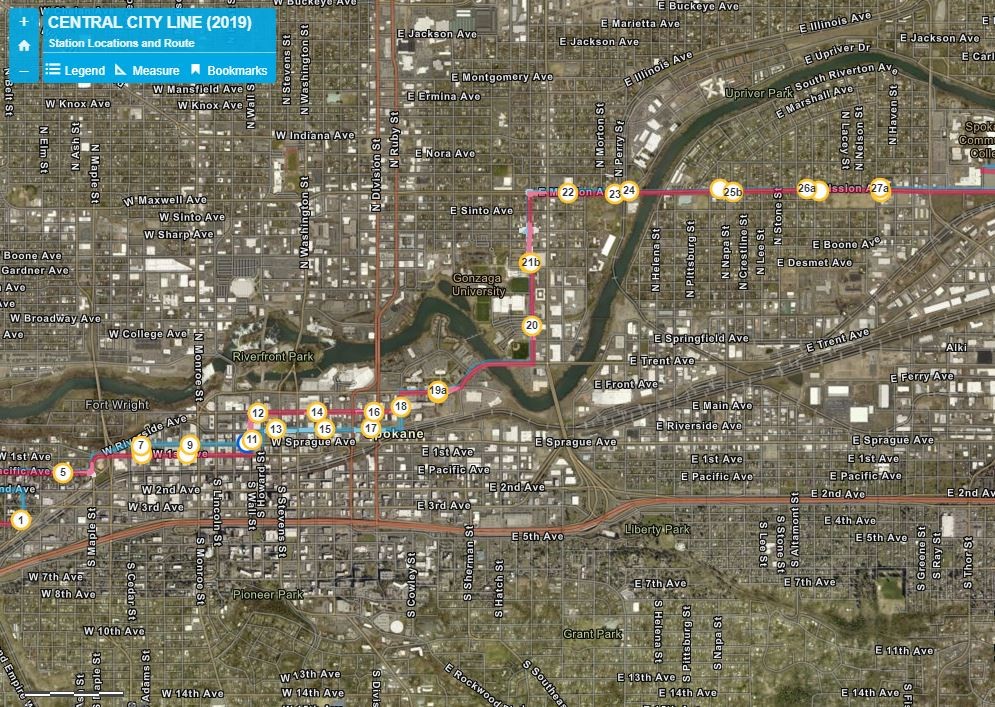STA Board Fully Funds Local Match for the Central City Line
Monday, July 29, 2019

The Spokane Transit Authority (STA) Board of Directors took action today to fully fund the $20.2 million local match for the Central City Line project – a six-mile, all-electric, corridor-based Bus Rapid Transit (BRT) line with frequent service between Browne’s Addition and Spokane Community College via downtown Spokane and the University District, including Gonzaga University.
The Board’s vote clears the path for STA Chief Executive Officer, E. Susan Meyer, to execute an agreement with the Federal Transit Administration (FTA) to accept a $53.4 million Small Starts Grant to support the project’s capital costs – a grant opportunity long supported by the region’s congressional delegation. Other matching funds to the project include $18.6 million in state and federal grants, obtained with the support of the state legislature and local community leaders.
In April, the FTA announced the allocation of the $53.4 million in federal funds to the Spokane project, pending STA’s fulfillment of all regulatory and administrative requirements, including immediate access to all non-federal funds in the revised $92.2 million project cost estimate. To formally achieve the funding obligation, the STA Board amended the agency’s 2020-2025 Capital Improvement Program to commit $20.2 million from its current fund balance toward the Central City Line.
“We’ve spent many years working toward this goal with the public and our local community partners, and today’s commitment keeps us on track,” said Candace Mumm, Spokane City Councilmember and STA Board Chair. “STA has zero debt and manages its resources carefully. That has put us in a position to fund the Central City Line’s local match while continuing to move forward with all the other beneficial transit projects underway.”
In 2011, after significant public input and key stakeholder engagement, STA and the City of Spokane approved the east/west transit corridor, as well as the fully electric, modern vehicle concept. Since then, STA has worked closely with the Downtown Spokane Partnership, Greater Spokane Incorporated, Avista, the Public Facilities District, Gonzaga University, WSU Spokane, Community Colleges of Spokane, and the neighborhoods through which the Central City Line will travel: Browne’s Addition, Riverside, Logan and Chief Garry Park.
In 2014, during the project’s initial conceptual phase, the Central City Line was estimated to cost $72 million. Jacobs, a consulting firm under contract with STA for project design and engineering, completed 60 percent design in March of this year. Reflecting more and better project detail and increases in construction materials and labor costs, Jacobs updated the cost estimate to $85.7 million.
As required by FTA, a third-party Project Management Oversight Contractor (PMOC) reviewed the 60 percent design cost estimate and recommended increasing project contingency funds, as well as extending the project completion date from the original September 2021 target to July 2022. Based on PMOC recommendations, the FTA directed STA to update the project cost estimate to $92.2 million.
“We know a lot more about the project than we did five years ago, and the economy is in a much better place,” said STA Board member and Spokane County Commissioner, Al French. “Good economies result in higher construction costs and that’s what’s reflected here, along with the contingency levels required by FTA. In the end, Spokane gets $72 million from this $20.2 million local match. That’s a good deal and allows us to deliver on a project voters approved in 2016.”
Prior to the board’s vote, STA staff presented a financial assessment demonstrating the agency’s ability to cover the revised Central City Line cost estimate without affecting designated reserves or voter-approved funding for other projects in the 10-year STA Moving Forward plan to maintain, improve and expand public transit service throughout the growing region.
“We are strategically moving forward with multiple capital and operating improvements designed to make transit easier and more convenient for everyone,“ said E. Susan Meyer, STA’s Chief Executive Officer. “The Central City Line is among those improvements, and it is transformational and exciting. Once construction begins, we’ll approach it with the same discipline to control costs and adhere to schedule as we do with all other projects.”
See the Central City Line interactive map and learn more about the project here.